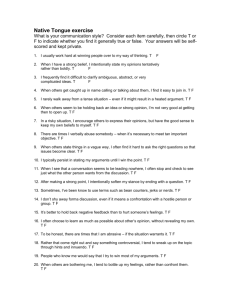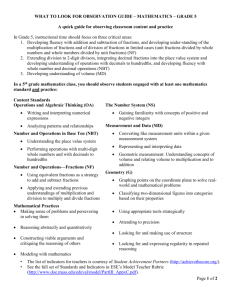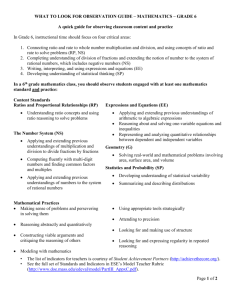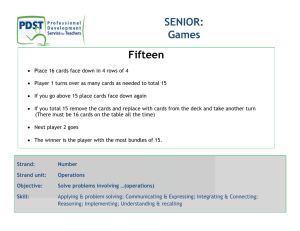Supplement to the Massachusetts Mathematics Curriculum
advertisement
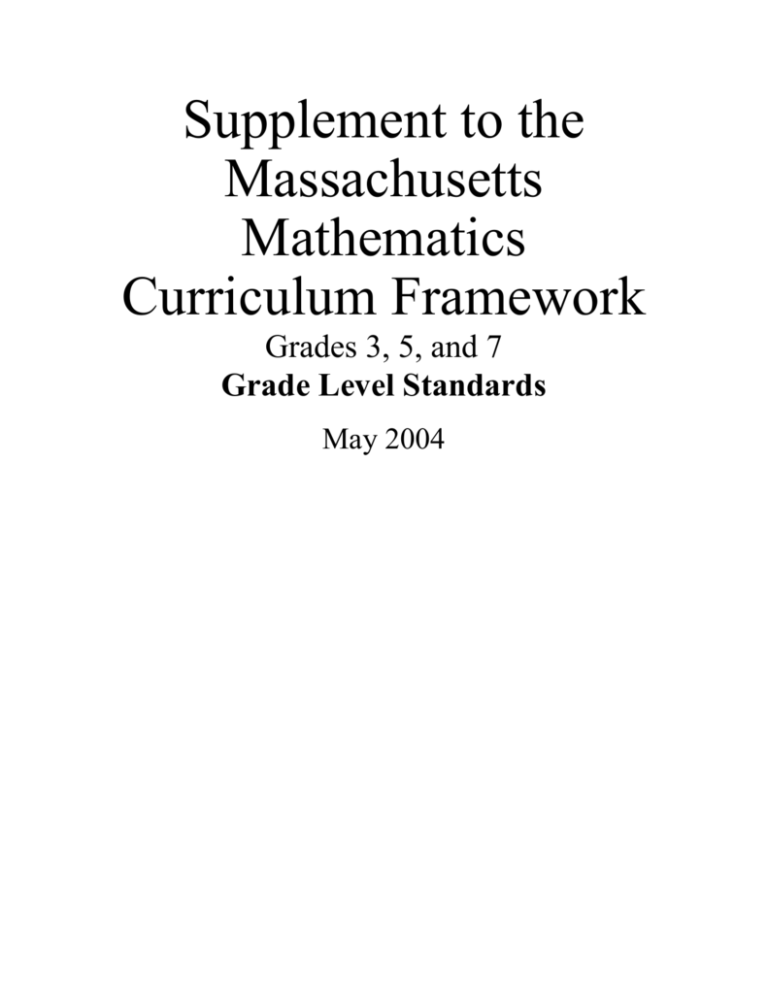
Supplement to the Massachusetts Mathematics Curriculum Framework Grades 3, 5, and 7 Grade Level Standards May 2004 Table of Contents Introduction 1 Grade 3 Standards 3 Grade 5 Standards 7 Grade 7 Standards 11 Acknowledgements 15 Introduction This Supplement is designed to be used with the Massachusetts Mathematics Curriculum Framework (2000), which contains learning standards written for two-year grade spans from grades PreK-K through 11-12.1 The Massachusetts Comprehensive Assessment System (MCAS) for Mathematics is based on these standards. In 2003, when work on the Supplement began, Massachusetts students were assessed in mathematics at grades 4, 6, 8, and 10. However, the federal No Child Left Behind (NCLB) Act requires annual testing in mathematics at each grade from grades 3 through 8, beginning with a first operational test in spring 2006. Therefore, Department staff, working with committees of educators and mathematicians, drafted grade-level standards for grades 3, 5, and 7, as presented in this Supplement. These grade-level standards were approved by the Board of Education on March 30, 2004. In creating grade-level standards, the Department is not changing the Curriculum Framework, because the standards the Board of Education approved in 2000 remain the same. Rather, these additional grade-level standards give educators, students, and parents more detailed guidance about the learning expected at each grade level from grades 3 to 8 and the content of future assessments in those grades. Contents of the Supplement The Supplement addresses all five mathematics strands that appear in the Mathematics Curriculum Framework. These five strands serve as the basis for the MCAS Mathematics assessments and are shown in the table below. Mathematics Curriculum Framework Strands Number Sense and Operations Patterns, Relations, and Algebra Geometry Measurement Data Analysis, Statistics, and Probability As educators and staff wrote and reviewed the standards for grades 3, 5, and 7, their goal was to provide a logical progression in the breadth and depth of what students will be expected to know and be able to do from one grade to the next. The following example shows how standards have been articulated for the specific grade levels; in this example, the grades 3 and 5 standards are presented for the first time in this Supplement, while the grades 1-2, 3-4, and 5-6 standards are quoted from the Framework. 1 The Framework is available at http://www.doe.mass.edu/frameworks/current.html. Number Sense and Operations Grade or Grade Span Learning Standard (grade-level standards are indicated by shading) 1-2 Name and write (in numerals) whole numbers to 1000, identify the place values of the digits, and order the numbers. 3 Exhibit an understanding of the values of the digits in the base ten number system by reading, modeling, writing, comparing, and ordering whole numbers through 9,999. 3-4 Exhibit an understanding of the base ten number system by reading, modeling, writing, and interpreting whole numbers to at least 100,000; demonstrating an understanding of the values of the digits; and comparing and ordering the numbers. 5 Demonstrate an understanding of place value through millions and thousandths. 5-6 Demonstrate an understanding of place value to billions and thousandths. The grade-level standards in this Supplement and the grade-span standards in the Curriculum Framework specify what students should know and be able to do as learners of mathematics at the end of each grade level. In instances when the grade-span standard (e.g., grades 7-8) is appropriate for the lower grade level (e.g., grade 7), the wording is intentionally left the same and is included at the lower grade level in this Supplement. Students are held responsible for learning standards listed at earlier grade levels as well as those listed at their current grade level. The Massachusetts Comprehensive Assessment System (MCAS) Mathematics assessment at any grade may include test items that assess standards from previous grades. Organization of the Supplement This document serves as a supplement to the existing Mathematics Curriculum Framework (2000). For ease of use, the Supplement is organized by grade level, grouping all grade 3 standards together, then all grade 5 standards, and then the grade 7 standards. Each standard has a unique identifier that consists of the following: • the grade level (3, 5, or 7); • the strand (N = Number Sense and Operations; P = Patterns, Relations and Algebra; G = Geometry; M = Measurement; and D = Data Analysis, Statistics, and Probability); and • the standard number. Grade 3 Standards Continue to address the grades PreK-2 standards as needed. NUMBER SENSE AND OPERATIONS STRAND Students engage in problem solving, communicating, reasoning, connecting, and representing as they: 3.N.1 Exhibit an understanding of the values of the digits in the base ten number system by reading, modeling, writing, comparing, and ordering whole numbers through 9,999. 3.N.2 Represent, order, and compare numbers through 9,999. Represent numbers using expanded notation (e.g., 853 = 8 x 100 + 5 x 10 + 3), and written out in words (e.g., eight hundred fifty-three). 3.N.3 Identify and represent fractions (between 0 and 1 with denominators through 10) as parts of unit wholes and parts of groups. Model and represent a mixed number (with denominator 2, 3, or 4) as a whole number and a fraction, e.g., 1 2/3, 3 1/2. 3.N.4 Locate on the number line and compare fractions (between 0 and 1 with denominators 2, 3, or 4, e.g., 2/3). 3.N.5 Recognize classes to which a number may belong (odd numbers, even numbers, and multiples of numbers through 10). Identify the numbers in those classes, e.g., the class of multiples of 7 between 1 and 29 consists of 7, 14, 21, 28. 3.N.6 Select, use, and explain various meanings and models of multiplication (through 10 x 10). Relate multiplication problems to corresponding division problems, e.g., draw a model to represent 5 x 6 and 30 ÷ 6. 3.N.7 Use the commutative (order) and identity properties of addition and multiplication on whole numbers in computations and problem situations, e.g., 3 + 4 + 7 = 3 + 7 + 4 = 10 + 4. 3.N.8 Select and use appropriate operations (addition, subtraction, multiplication, and division) to solve problems, including those involving money. This standard is intentionally the same as standard 4.N.10. 3.N.9 Know multiplication facts through 10 x 10 and related division facts, e.g., 9 x 8 = 72 and 72 ÷ 9 = 8. Use these facts to solve related problems, e.g., 3 x 5 is related to 3 x 50. 3.N.10 Add and subtract (up to four-digit numbers) and multiply (up to two-digit numbers by a one-digit number) accurately and efficiently. 3.N.11 Round whole numbers through 1,000 to the nearest 10, 100, and 1,000. 3.N.12 Understand and use the strategies of rounding and regrouping to estimate quantities, measures, and the results of whole-number computations (addition, subtraction, and multiplication) up to two-digit whole numbers and amounts of money to $100, and to judge the reasonableness of the answer. 3.N.13 Use concrete objects and visual models to add and subtract (only when the answer is greater than or equal to zero) common fractions (halves, thirds, fourths, sixths, and eighths) with like denominators. PATTERNS, RELATIONS, AND ALGEBRA STRAND Students engage in problem solving, communicating, reasoning, connecting, and representing as they: 3.P.1 Create, describe, extend, and explain symbolic (geometric) patterns and addition and subtraction patterns, e.g., 2, 6, 10, …; and 50, 45, 40.… 3.P.2 Determine which symbol (<, >, or =) is appropriate for a given number sentence, e.g., 7 x 8 .?. 49 + 6. 3.P.3 Determine the value of a variable (through 10) in simple equations involving addition, subtraction, or multiplication, e.g., 2 + = 9; 5 x [insert upside down capital delta here] = 35. 3.P.4 Write number sentences using +, –, x, ÷, <, =, and/or > to represent mathematical relationships in everyday situations. GEOMETRY STRAND Students engage in problem solving, communicating, reasoning, connecting, and representing as they: 3.G.1 Compare and analyze attributes and other features (e.g., number of sides, corners, diagonals, and lines of symmetry) of two-dimensional geometric shapes. 3.G.2 Describe, model, draw, compare, and classify two-dimensional shapes, e.g., circles, triangles, and quadrilaterals. Identify and describe simple three-dimensional shapes, e.g., cubes, spheres, and pyramids. 3.G.3 Identify angles as right angles, less than a right angle, and greater than a right angle. 3.G.4 Identify and draw parallel lines, perpendicular lines, and other intersecting lines. 3.G.5 Using ordered pairs of whole numbers and/or letters, locate and identify points on a grid. 3.G.6 Identify and draw lines of symmetry in two-dimensional shapes. 3.G.7 Predict and explain the results of taking apart and combining two-dimensional shapes. MEASUREMENT STRAND Students engage in problem solving, communicating, reasoning, connecting, and representing as they: 3.M.1 Demonstrate an understanding of the attributes length, area, and weight, and select the appropriate type of unit for measuring each attribute using both the U.S. Customary (English) and metric systems. 3.M.2 Carry out simple unit conversions within a system of measurement, e.g., hours to minutes, cents to dollars, yards to feet or inches, etc. This standard is intentionally the same as standard 4.M.2. 3.M.3 Identify time to the minute on analog and digital clocks using a.m. and p.m. Compute elapsed time, using a clock for times less than one hour (i.e., minutes since), and using a calendar (e.g., days since). 3.M.4 Estimate and find area and perimeter of a rectangle, using diagrams and grids, or by measuring. 3.M.5 Identify and use appropriate metric and U.S. Customary (English) units and tools (e.g., ruler, scale, thermometer, clock) to estimate, measure, and solve problems involving length, area, weight, temperature, and time. DATA ANALYSIS, STATISTICS, AND PROBABILITY STRAND Students engage in problem solving, communicating, reasoning, connecting, and representing as they: 3.D.1 Collect and organize data using observations, measurements, surveys, or experiments, and identify appropriate ways to display the data. This standard is intentionally the same as standard 4.D.1. 3.D.2 Match representations of a data set in the forms of tables, line plots, pictographs, tallies, or bar graphs with the actual data set. 3.D.3 Construct and draw conclusions from representations of data sets in the forms of tables, line plots, pictographs, tallies, and bar graphs. 3.D.4 List and count the number of possible combinations of objects from two sets, e.g., how many different outfits can one make from a set of two sweaters and a set of three skirts? Grade 5 Standards Continue to address the grades PreK-4 standards as needed. NUMBER SENSE AND OPERATIONS STRAND Students engage in problem solving, communicating, reasoning, connecting, and representing as they: 5.N.1 Demonstrate an understanding of (positive integer) powers of ten, e.g., 102, 105. 5.N.2 Demonstrate an understanding of place value through millions and thousandths. 5.N.3 Represent and compare large (millions) and small (thousandths) positive numbers in various forms, such as expanded notation without exponents, e.g., 9724 = 9 x 1000 + 7 x 100 + 2 x 10 + 4. 5.N.4 Demonstrate an understanding of fractions as a ratio of whole numbers, as parts of unit wholes, as parts of a collection, and as locations on the number line. This standard is intentionally the same as standard 6.N.4. 5.N.5 Identify and determine common equivalent fractions (with denominators 2, 4, 5, 10) and mixed numbers (with denominators 2, 4, 5, 10), decimals, and percents (through one hundred percent), e.g., 3/4 = 0.75 = 75%. 5.N.6 Find and position whole numbers, positive fractions, positive mixed numbers, and positive decimals on a number line. 5.N.7 Compare and order whole numbers, positive fractions, positive mixed numbers, positive decimals, and percents. 5.N.8 Apply the number theory concepts of common factor, common multiple, and divisibility rules for 2, 3, 5, and 10 to the solution of problems. Demonstrate an understanding of the concepts of prime and composite numbers. 5.N.9 Solve problems involving multiplication and division of whole numbers, and multiplication of positive fractions with whole numbers. 5.N.10 Demonstrate an understanding of how parentheses affect expressions involving addition, subtraction, and multiplication, and use that understanding to solve problems, e.g., 3 x (4 + 2) = 3 x 6. 5.N.11 Demonstrate an understanding of the inverse relationship of addition and subtraction, and use that understanding to simplify computation and solve problems. This standard is intentionally the same as standard 6.N.12. 5.N.12 Accurately and efficiently add and subtract whole numbers and positive decimals. Multiply and divide (using double-digit divisors) whole numbers. Multiply positive decimals with whole numbers. 5.N.13 Accurately and efficiently add and subtract positive fractions and mixed numbers with like denominators and with unlike denominators (2, 4, 5, 10 only); multiply positive fractions with whole numbers. Simplify fractions in cases when both the numerator and the denominator have 2, 3, 4, 5, or 10 as a common factor. 5.N.14 Estimate sums and differences of whole numbers, positive fractions, and positive decimals. Estimate products of whole numbers and products of positive decimals with whole numbers. Use a variety of strategies and judge the reasonableness of the answer. PATTERNS, RELATIONS, AND ALGEBRA STRAND Students engage in problem solving, communicating, reasoning, connecting, and representing as they: 5.P.1 Analyze and determine the rules for extending symbolic, arithmetic, and geometric patterns and progressions, e.g., ABBCCC; 1, 5, 9, 13…; 3, 9, 27... This standard is intentionally the same as standard 6.P.1. 5.P.2 Replace variables with given values and evaluate/simplify, e.g., 2() + 3 when = 4. This standard is intentionally the same as standard 6.P.2. 5.P.3 Use the properties of equality to solve problems with whole numbers, e.g., if + 7 = 13, then = 13 – 7, therefore = 6 ; if 3 x = 15, then = 15 ÷ 3, therefore = 5. 5.P.4 Represent real situations and mathematical relationships with concrete models, tables, graphs, and rules in words and with symbols, e.g., input-output tables. This standard is intentionally the same as standard 6.P.4. 5.P.5 Solve problems involving proportional relationships using concrete models, tables, graphs, and paper-pencil methods. 5.P.6 Interpret graphs that represent the relationship between two variables in everyday situations. GEOMETRY STRAND Students engage in problem solving, communicating, reasoning, connecting, and representing as they: 5.G.1 Identify, describe, and compare special types of triangles (isosceles, equilateral, right) and quadrilaterals (square, rectangle, parallelogram, rhombus, trapezoid), e.g., recognize that all equilateral triangles are isosceles, but not all isosceles triangles are equilateral. 5.G.2 Identify, describe, and compare special types of three-dimensional shapes (cubes, prisms, spheres, pyramids) based on their properties, such as edges and faces. 5.G.3 Identify relationships among points and lines, e.g., intersecting, parallel, perpendicular. 5.G.4 Using ordered pairs of whole numbers (including zero), graph, locate, and identify points, and describe paths on the Cartesian coordinate plane. 5.G.5 Describe and perform transformations on two-dimensional shapes, e.g., translations, rotations, and reflections. 5.G.6 Identify and describe line symmetry in two-dimensional shapes, including shapes that have multiple lines of symmetry. 5.G.7 Determine if two triangles or two quadrilaterals are congruent by measuring sides or a combination of sides and angles, as necessary; or by motions or series of motions, e.g., translations, rotations, and reflections. MEASUREMENT STRAND Students engage in problem solving, communicating, reasoning, connecting, and representing as they: 5.M.1 Apply the concepts of perimeter and area to the solution of problems involving triangles and rectangles. Apply formulas where appropriate. 5.M.2 Identify, measure, describe, classify, and draw various angles. Draw triangles given two sides and the angle between them, or given two angles and the side between them, e.g., draw a triangle with one right angle and two sides congruent. 5.M.3 Solve problems involving simple unit conversions within a system of measurement. 5.M.4 Find volumes and surface areas of rectangular prisms. This standard is intentionally the same as standard 6.M.6. 5.M.5 Find the sum of the measures of the interior angles in triangles by measuring the angles, and without measuring the angles. DATA ANALYSIS, STATISTICS, AND PROBABILITY STRAND Students engage in problem solving, communicating, reasoning, connecting, and representing as they: 5.D.1 Given a set of data, find the median, mean, mode, maximum, minimum, and range, and apply to solutions of problems. 5.D.2 Construct and interpret line plots, line graphs, and bar graphs. Interpret and label circle graphs. 5.D.3 Predict the probability of outcomes of simple experiments (e.g., tossing a coin, rolling a number cube) and test the predictions. Grade 7 Standards Continue to address the grades PreK-6 standards as needed. NUMBER SENSE AND OPERATIONS STRAND Students engage in problem solving, communicating, reasoning, connecting, and representing as they: 7.N.1 Compare, order, estimate, and translate among integers, fractions and mixed numbers (i.e., rational numbers), decimals, and percents. This standard is intentionally the same as standard 8.N.1. 7.N.2 Use ratios and proportions in the solution of problems involving unit rates, scale drawings, and reading of maps. 7.N.3 Represent numbers in scientific notation (positive powers of ten only) and use that notation in problem situations. 7.N.4 Demonstrate an understanding of absolute value, e.g., |-3| = |3| = 3. This standard is intentionally the same as standard 8.N.6. 7.N.5 Apply the rules of positive integer exponents to the solution of problems. Extend the Order of Operations to include positive integer exponents. 7.N.6 Use the inverse relationships of addition and subtraction, and of multiplication and division, to simplify computations and solve problems, e.g., multiplying by 1/2 or 0.5 is the same as dividing by 2. 7.N.7 Estimate and compute with fractions (including simplification of fractions), integers, decimals, and percents (including those greater than 100 and less than 1). This standard is intentionally the same as standard 8.N.10. 7.N.8 Determine when an estimate rather than an exact answer is appropriate and apply in problem situations. This standard is intentionally the same as standard 8.N.11. 7.N.9 Select and use appropriate operations—addition, subtraction, multiplication, division, and positive integer exponents—to solve problems with rational numbers (including negatives). This standard is intentionally the same as standard 8.N.12. PATTERNS, RELATIONS, AND ALGEBRA STRAND Students engage in problem solving, communicating, reasoning, connecting, and representing as they: 7.P.1 Extend, represent, analyze, and generalize a variety of patterns with tables, graphs, words, and, when possible, symbolic expressions. Include arithmetic and geometric progressions, e.g., compounding. This standard is intentionally the same as standard 8.P.1. 7.P.2 Evaluate simple algebraic expressions for given variable values, e.g., 3a2 – b for a = 3 and b = 7. This standard is intentionally the same as standard 8.P.2. 7.P.3 Create and use symbolic expressions for linear relationships and relate them to verbal, tabular, and graphical representations. 7.P.4 Solve linear equations using tables, graphs, models, and algebraic methods. 7.P.5 Identify, describe, and analyze linear relationships between two variables. Compare positive rate of change, e.g., y = 3x + 1, to negative rate of change, e.g., y = –3x + 1. 7.P.6 Use linear equations to model and analyze problems involving proportional relationships. Use technology as appropriate. This standard is intentionally the same as standard 8.P.9. GEOMETRY STRAND Students engage in problem solving, communicating, reasoning, connecting, and representing as they: 7.G.1 Analyze, apply, and explain the relationship between the number of sides and the sums of the interior angle measures of polygons. 7.G.2 Classify figures in terms of congruence and similarity, and apply these relationships to the solution of problems. This standard is intentionally the same as standard 8.G.2. 7.G.3 Demonstrate an understanding of the relationships of angles formed by intersecting lines, including parallel lines cut by a transversal. This standard is intentionally the same as standard 8.G.3. 7.G.4 Graph points and identify coordinates of points on the Cartesian coordinate plane (all four quadrants).2 7.G.5 Use a ruler, protractor, and compass to draw polygons and circles. 7.G.6 Predict the results of translations and reflections of figures on unmarked or coordinate planes and draw the transformed figure. 7.G.7 Identify three-dimensional figures (e.g., prisms, pyramids) by their physical appearance, distinguishing attributes, and spatial relationships such as parallel faces. This standard is intentionally the same as standard 8.G.7. MEASUREMENT STRAND Students engage in problem solving, communicating, reasoning, connecting, and representing as they: 7.M.1 Select, convert (within the same system of measurement), and use appropriate units of measurement or scale. This standard is intentionally the same as standard 8.M.1. 7.M.2 Given the formulas, convert from one system of measurement to another. Use technology as appropriate. This standard is intentionally the same as standard 8.M.2. 7.M.3 Demonstrate an understanding of the concepts and apply formulas and procedures for determining measures, including those of area and perimeter/circumference of parallelograms, trapezoids, and circles. Given the formulas, determine the surface area and volume of rectangular prisms and cylinders. Use technology as appropriate. DATA ANALYSIS, STATISTICS, AND PROBABILITY STRAND Students engage in problem solving, communicating, reasoning, connecting, and representing as they: 7.D.1 Select, create, interpret, and utilize the following tabular and graphical representations of data: circle graphs, Venn diagrams, stem-and-leaf plots, tables, and charts. 7.D.2 Find, describe, and interpret appropriate measures of central tendency (mean, median, and mode) and spread (range) that represent a set of data. Use these notions to compare different sets of data. This standard is intentionally the same as standard 8.D.3. 7.D.3 Use tree diagrams, tables, organized lists, and area models to compute probabilities for simple compound events, e.g., multiple coin tosses or rolls of number cubes. Acknowledgements Consultants Bethe McBride, Mathematics Curriculum Coordinator, Haverhill Public Schools Wilfried Schmid, Professor of Mathematics, Harvard University Educators from the following Massachusetts public school districts and schools commented on the drafts of this Supplement: Adams-Cheshire Regional School District Amherst-Pelham Regional School District Arlington Public Schools Boston Public Schools Boston Renaissance Charter School Brookline Public Schools Burlington Public Schools Easthampton Public Schools Edward Brooke Charter School Framingham Public Schools Franklin Public Schools Grafton Public Schools Groton-Dunstable Regional School District Haverhill Public Schools Hingham Public Schools Holyoke Public Schools Lawrence Public Schools Lexington Public Schools Lincoln Public Schools Lynn Public Schools Lynnfield Public Schools Medfield Public Schools Medford Public Schools Monson Public Schools Nantucket Public Schools North Andover Public Schools North Middlesex Regional School District Northborough Public Schools Northampton Public Schools Pentucket Regional School District Springfield Public Schools Tyngsborough Public Schools Wellesley Public Schools West Springfield Public Schools Westford Public Schools Westwood Public Schools Williamsburg Public Schools Woburn Public Schools Worcester Public Schools Massachusetts Department of Education Staff Catherine Bowler, Science Content Specialist Jonathan Considine, NAEP State Coordinator Haley Freeman, Mathematics Assessment Specialist Mark Johnson, Mathematics Assessment Specialist Marcia Kastner, Mathematics Assessment Lead Barbara Libby, Director, Office for Mathematics, Science, and Technology/Engineering Mark McQuillan, Deputy Commissioner of Education Jeff Nellhaus, Associate Commissioner, Curriculum, Assessment, and Instructional Technology Massachusetts Department of Education This document was prepared by the Massachusetts Department of Education Dr. David P. Driscoll, Commissioner of Education Board of Education Members Mr. James A. Peyser, Chairman, Milton Mr. Henry M. Thomas, III, Vice-Chairman, Springfield Ms. Harneen Chernow, Jamaica Plain Mr. J. Richard Crowley, Andover Mr. Jeff DeFlavio, Chair, Student Advisory Council, Belmont Dr. Judith I. Gill, Chancellor, Board of Higher Education, Boston Dr. Roberta R. Schaefer, Worcester Dr. Abigail M. Thernstrom, Lexington Dr. David P. Driscoll, Commissioner of Education and Secretary to the Board The Massachusetts Department of Education, an Affirmative Action employer, is committed to ensuring that all of its programs and facilities are accessible to all members of the public. We do not discriminate on the basis of age, color, disability, national origin, race, religion, sex, or sexual orientation. Copyright © 2004 Massachusetts Department of Education Permission is hereby granted to copy any or all parts of this document for non-commercial educational purposes. Please credit the “Massachusetts Department of Education.” This document printed on recycled paper 350 Main Street, Malden, Massachusetts 02148-5023 • Telephone: 781-338-3000


